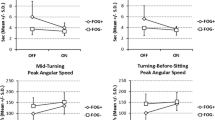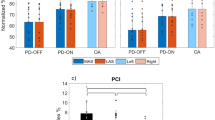Abstract
Dopaminergic activity decreases in older adults (OAs) with normal aging and is further reduced in Parkinson’s disease (PD), affecting cortical motor and sensorimotor pathways. Levodopa is the prevailing therapy to counter dopamine loss in PD, though not all PD motor signs improve with levodopa. The purpose of this preliminary study was to explore the effects of levodopa on sensorimotor inhibition, gait and quiet standing in OAs and to investigate the relationships between sensorimotor inhibition and both gait and standing balance both OFF- and ON-levodopa. Fifteen OA males completed a gait, balance and sensorimotor assessments before and 1 h after they were given a 100 mg dose of levodopa. Short-latency afferent inhibition quantified sensorimotor inhibition. Wearable sensors characterized gait (two-minute walk) and standing balance (1-min stance). No sensorimotor inhibition, gait, or standing balance measures changed from OFF- to ON-levodopa. When OFF-levodopa, worse inhibition significantly related to increased double stance (r = 0.62; p = 0.01), increased jerkiness of sway (r = 0.57; p = 0.03) and sway area (r = 0.58; p = 0.02). While ON-levodopa, worse inhibition related to increased arm swing range of motion (r = 0.63; p = 0.01) and jerkiness of sway (r = 0.53; p = 0.04). The relationship between SAI and arm swing excursion significantly changed from OFF- to ON-levodopa (z = − 3.05; p = 0.002; 95% confidence interval = − 0.95, − 0.21). Sensorimotor inhibition relationships to both gait and balance may be affected by dopamine in OAs. Cortical restructuring due to the loss of dopamine may be responsible for the heterogeneity of levodopa effect in people with PD and OAs.


Similar content being viewed by others
Data availability statement
The data sets generated during and/or analyzed during the current study are available from the corresponding author on reasonable request.
References
Alcaro A, Huber R, Panksepp J (2007) Behavioral functions of the mesolimbic dopaminergic system: an affective neuroethological perspective. Brain Res Rev 56:283–321
Amboni M, Barone P, Hausdorff JM (2013) Cognitive contributions to gait and falls: evidence and implications. Mov Disord 28:1520–1533
Bohnen NI, Kanel P, Müller ML (2018) Molecular imaging of the cholinergic system in Parkinson’s disease. Int Rev Neurobiol 141:211–250
Bourdy R, Sánchez-Catalán M-J, Kaufling J et al (2014) Control of the nigrostriatal dopamine neuron activity and motor function by the tail of the ventral tegmental area. Neuropsychopharmacology 39:2788–2798
Cohen J (1977) Statistical power analysis for the behavioral sciences (rev). Lawrence Erlbaum Associates, Inc., Mahwah
Cohen JA, Verghese J, Zwerling JL (2016) Cognition and gait in older people. Maturitas 93:73–77
Curtze C, Nutt JG, Carlson-Kuhta P, Mancini M, Horak FB (2015) Levodopa is a double-edged sword for balance and gait in people with Parkinson’s disease. Mov Disord 30:1361–1370. https://doi.org/10.1002/mds.26269
Di Lazzaro V, Oliviero A, Profice P et al (2000) Muscarinic receptor blockade has differential effects on the excitability of intracortical circuits in the human motor cortex. Exp Brain Res 135:455–461. https://doi.org/10.1007/s002210000543
Di Lazzaro V, Oliviero A, Tonali PA et al (2002) Noninvasive in vivo assessment of cholinergic cortical circuits in AD using transcranial magnetic stimulation. Neurology 59:392–397
Di Lazzaro V, Oliviero A, Saturno E et al (2005) Effects of lorazepam on short latency afferent inhibition and short latency intracortical inhibition in humans. J Physiol 564:661–668. https://doi.org/10.1113/jphysiol.2004.061747
Diedenhofen B, Musch J (2015) cocor: a comprehensive solution for the statistical comparison of correlations. PLoS ONE 10:e0121945
Floel A, Vomhof P, Lorenzen A, Roesser N, Breitenstein C, Knecht S (2008) Levodopa improves skilled hand functions in the elderly. Eur J Neurosci 27:1301–1307
Julkunen P, Säisänen L, Danner N, Niskanen E, Hukkanen T, Mervaala E, Könönen M (2009) Comparison of navigated and non-navigated transcranial magnetic stimulation for motor cortex mapping, motor threshold and motor evoked potentials. Neuroimage 44:790–795
LaRoche DP, Greenleaf BL, Croce RV, McGaughy JA (2014) Interaction of age, cognitive function, and gait performance in 50–80-year-olds. Age 36:1–12
Linssen A, Sambeth A, Vuurman E, Riedel W (2014) Cognitive effects of methylphenidate and levodopa in healthy volunteers. Eur Neuropsychopharmacol 24:200–206
Luo Y, Roth GS (2000) The roles of dopamine oxidative stress and dopamine receptor signaling in aging and age-related neurodegeneration. Antioxid Redox Signal 2:449–460
Maki BE (1997) Gait changes in older adults: predictors of falls or indicators of fear. J Am Geriatr Soc 45:313–320
Mancini M, King L, Salarian A, Holmstrom L, McNames J, Horak FB (2011) Mobility lab to assess balance and gait with synchronized body-worn sensors. J Bioeng Biomed Sci Suppl 1:007. https://doi.org/10.4172/2155-9538.S1-007
Martini DN, Morris R, Kelly VE et al (2020) Sensorimotor inhibition and mobility in genetic subgroups of Parkinson’s disease. Front Neurol 11:893
Martini DN, Morris R, Madhyastha TM et al (2021) Relationship between sensorimotor inhibition and mobility in older adults with and without Parkinson’s disease. J Gerontol Ser A 76:630–637
Meng X-L, Rosenthal R, Rubin DB (1992) Comparing correlated correlation coefficients. Psychol Bull 111:172
Obi K, Amano I, Takatsuru Y (2018) Role of dopamine on functional recovery in the contralateral hemisphere after focal stroke in the somatosensory cortex. Brain Res 1678:146–152
Pelosin E, Ogliastro C, Lagravinese G et al (2016) Attentional control of gait and falls: is cholinergic dysfunction a common substrate in the elderly and Parkinson’s disease? Front Aging Neurosci 8:104. https://doi.org/10.3389/fnagi.2016.00104
Pelosin E, Cerulli C, Ogliastro C et al (2020) A multimodal training modulates short afferent inhibition and improves complex walking in a cohort of faller older adults with an increased prevalence of Parkinson’s disease. J Gerontol Ser A 75:722–728
Rochester L, Yarnall AJ, Baker MR, David RV, Lord S, Galna B, Burn DJ (2012) Cholinergic dysfunction contributes to gait disturbance in early Parkinson’s disease. Brain 135:2779–2788. https://doi.org/10.1093/brain/aws207
Sailer A, Molnar GF, Paradiso G, Gunraj CA, Lang AE, Chen R (2003) Short and long latency afferent inhibition in Parkinson’s disease. Brain 126:1883–1894. https://doi.org/10.1093/brain/awg183
Ueno S, Sekino M (2021) Figure-eight coils for magnetic stimulation: from focal stimulation to deep stimulation. Front Hum Neurosci 15:1–6
Verghese J, Robbins M, Holtzer R, Zimmerman M, Wang C, Xue X, Lipton RB (2008) Gait dysfunction in mild cognitive impairment syndromes. J Am Geriatr Soc 56:1244–1251. https://doi.org/10.1111/j.1532-5415.2008.01758.x
Verlinden VJ, van der Geest JN, Hofman A, Ikram MA (2014) Cognition and gait show a distinct pattern of association in the general population. Alzheimers Dement 10:328–335
Vo A, Seergobin KN, MacDonald PA (2018) Independent effects of age and levodopa on reversal learning in healthy volunteers. Neurobiol Aging 69:129–139
Volkow ND, Ding Y-S, Fowler JS et al (1996) Dopamine transporters decrease with age. J Nucl Med 37:554–559
Wilson J, Alcock L, Yarnall AJ et al (2020) Gait progression over 6 years in Parkinson’s disease: effects of age, medication, and pathology. Front Aging Neurosci 12:577435
Young-Bernier M, Tanguay AN, Davidson PS, Tremblay F (2014) Short-latency afferent inhibition is a poor predictor of individual susceptibility to rTMS-induced plasticity in the motor cortex of young and older adults. Front Aging Neurosci 6:182
Acknowledgements
This publication was possible due to the work and effort of each listed co-author. DNM, FBH, and JGN conceptualized and received funding; DNM, RM and GH contributed to recruitment and data collection; DNM and GH contributed to data processing and analyses; Each author contributed to interpretation; DNM wrote the initial draft, RM, VEK, JGN and FBH contributed to editing and review.
Funding
This work was supported by the National Institutes of Neurological Disorders and Stroke (P50 NS062684), the US Department of Veterans Affairs (101 CX001702), and the Medical Research Foundation of Oregon (ANEUR0967).
Author information
Authors and Affiliations
Corresponding author
Ethics declarations
Conflict of interest
OHSU and Dr. Horak have a significant financial interest in APDM Wearable Technologies, a Clario company, that may have a commercial interest in the results of this research and technology. This potential conflict has been reviewed and managed by OHSU. No other author has a financial disclosure to claim.
Additional information
Communicated by Winston D Byblow.
Publisher's Note
Springer Nature remains neutral with regard to jurisdictional claims in published maps and institutional affiliations.
Rights and permissions
Springer Nature or its licensor (e.g. a society or other partner) holds exclusive rights to this article under a publishing agreement with the author(s) or other rightsholder(s); author self-archiving of the accepted manuscript version of this article is solely governed by the terms of such publishing agreement and applicable law.
About this article
Cite this article
Martini, D.N., Morris, R., Harker, G. et al. Exploring the effects of dopamine on sensorimotor inhibition and mobility in older adults. Exp Brain Res 241, 127–133 (2023). https://doi.org/10.1007/s00221-022-06509-1
Received:
Accepted:
Published:
Issue Date:
DOI: https://doi.org/10.1007/s00221-022-06509-1




